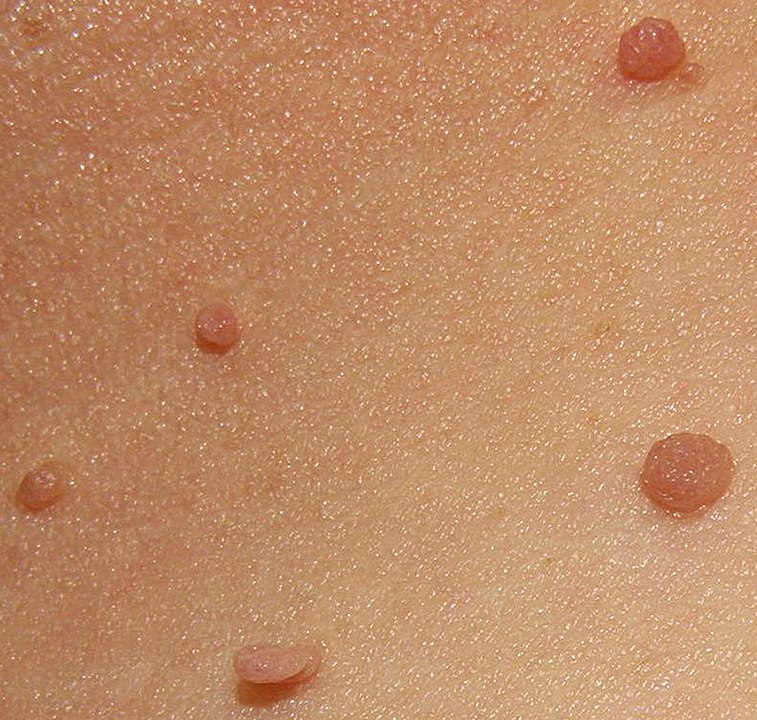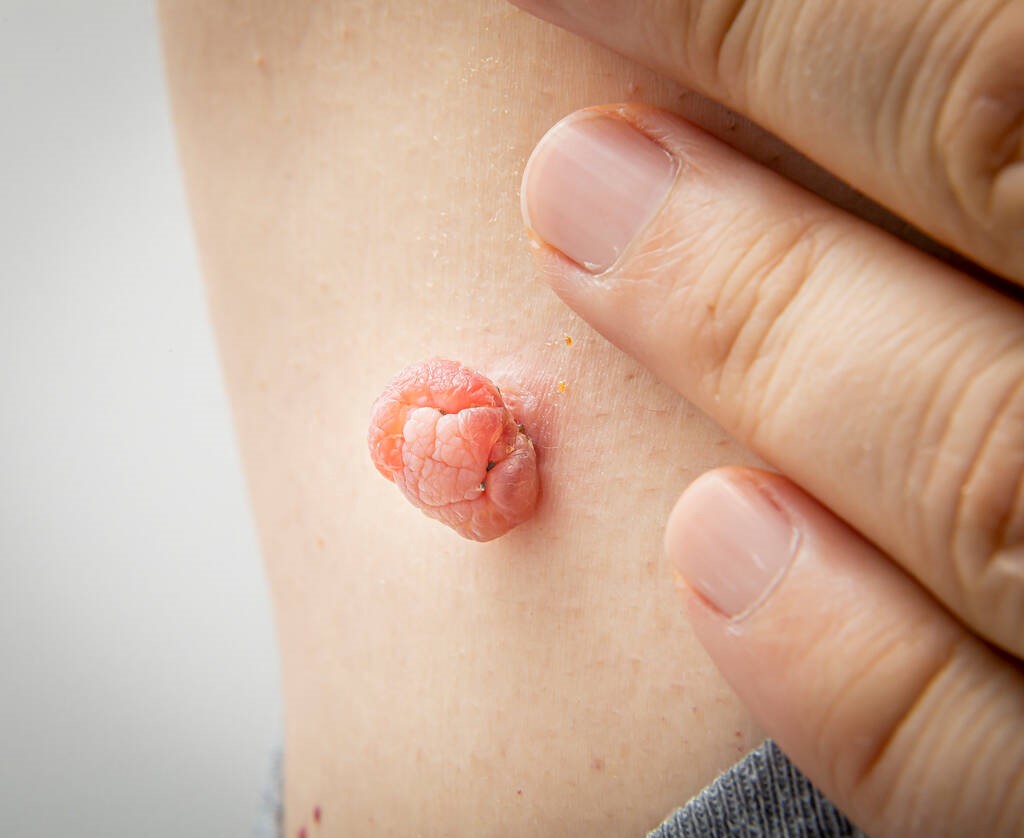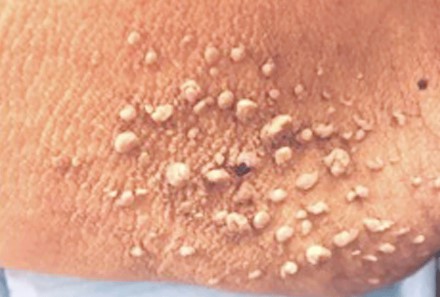Skin Tag Removal
Skin tags are a very common skin condition, affecting up to 46% of the general population, with over 3 million new cases diagnosed in the United States each year. These soft, flesh-colored skin growths, usually connected by a thin stalk, are more prevalent in adults over 40. Skin tags—also called acrochordons—typically form when skin rubs against itself and are most often found in the neck folds, armpits, groin, breasts, and eyelids. While skin tags are harmless, they can be located in highly visible areas, prompting many patients to seek removal. In some cases, they can rub against clothing, leading to itching, skin irritation, or bleeding. The best initial step for anyone looking to remove skin tags is to schedule a consultation with a board-certified dermatologist, such as Dr. Michele Green.
Dr. Green offers several options for skin tag removal at her dermatology office on the Upper East Side of New York City, including electrodesiccation, cryosurgery, and excision. The best choice depends on the location, size, and shape of the skin tag, and Dr. Green may combine treatments to achieve optimal results. Electrodesiccation involves using a tiny needle to deliver an electric current that cauterizes the skin tag, which then scabs over and heals. Smaller skin tags can be treated with cryotherapy, where liquid nitrogen is directly applied to freeze the skin tag on contact. Larger skin tags with a thicker stalk may be removed through surgical excision, and a biopsy may be taken for histological examination to rule out other skin conditions like warts or skin cancer. To determine which treatment is best for you, you can schedule a consultation with Dr. Green.
Experienced, board-certified dermatologist Dr. Michele Green has been expertly treating patients at her Upper East Side, New York City dermatology office for over 25 years. Skilled in a wide range of medical and cosmetic treatments, including skin tag removal, Dr. Green is adept at creating personalized treatment plans that meet each patient’s unique needs and aesthetic goals. Renowned for high patient satisfaction, Dr. Green has consistently been voted one of the best dermatologists in New York City by publications like Castle Connolly, Super Doctors, and New York Magazine.
What are skin tags?
Skin tags, also known as acrochordons, are benign skin lesions that can grow on areas of the body where the skin is constantly rubbing together, including the armpits, neck folds, groin, breasts, eyelids, and buttocks. Often ranging in size from two millimeters to one centimeter, these skin lesions are composed of collagen and blood vessels and surrounded by soft skin tissue. Sometimes, they hang from the affected area by a thin stalk of skin tissue and are usually flesh-colored or a little darker. Skin tags may form individually, but they often appear in clusters. While these skin growths are harmless, meaning they are not indicative of skin cancer, they can form in highly visible areas, prompting patients to seek removal for cosmetic reasons. Some patients may find skin tags itchy and irritating when they rub against clothing.

NeckAcrochordons By Jmarchn – Own work, CC BY-SA 3.0
Why do skin tags appear?
The exact cause of skin tags is still unknown. However, several risk factors can contribute to their development. Often, skin tags form when the skin rubs against itself, making pregnant women, those who are overweight, or people with loose skin more likely to get skin tags. People with a family history of skin tags are also at higher risk. Skin tags have also been linked to other conditions, including:
- Human Papillomavirus (HPV)—Human Papillomavirus, including HPV types 6 and 11, which are low-risk, has been linked to skin tags. If you notice skin tags in the groin, genital, or anal areas, it is advised to have these lesions removed and tested for HPV. Although skin tags are typically benign, their connection to HPV in these sensitive regions makes removal advisable, as some high-risk papillomaviruses have been linked to skin cancer.
- Metabolic syndromes—The appearance of skin tags can also signal other health problems, such as diabetes. In individuals with type 2 diabetes, the body resists insulin, and abnormal levels can lead to hormonal changes that impact cellular turnover in the skin. Because the skin’s ability to produce healthy cells is impaired, skin tags form and will continue to develop until the body is balanced and insulin levels are stabilized. Although diabetes can cause skin tags, not everyone with diabetes develops them.
- Obesity—Obesity may cause hormonal changes that contribute to the development of skin tags. People with obesity might experience increased skin friction in areas prone to skin tags, leading to an increased risk of developing them.
- Friction—Skin friction is a common cause of skin tags, especially around the neck, underarms, beneath the breasts, groin, buttocks, and skin folds in overweight patients. Wearing tight clothes or engaging in activities that cause the skin to rub together can also lead to skin tags.
- Brit-Hogg-Dube syndrome—A very rare genetic condition usually found in children. It is linked to the development of skin tags, mainly on the face and upper body. It is also connected to skin tumors, such as multiple fibrofolliculomas and trichodiscomas. Patients with this condition may also develop carcinomas in the kidneys and colon.
- Polycystic ovary syndrome—A hormonal disorder that causes enlarged ovaries with small cysts. Patients may also experience skin tags and various other dermatologic conditions, such as acne, acanthosis nigricans, and abnormal hair growth.
What is the skin tag removal process?
Skin tags are harmless growths that affect over 3 million Americans each year. While they are quite common, they often appear in highly visible areas of the body, including the face (eyelids) and neck, prompting patients to seek removal for cosmetic reasons. Skin tags can also develop in areas that rub against clothing in itchy or uncomfortable ways, such as under the breasts, in the armpits, and in the genital region. Patients considering removal should first consult with a board-certified dermatologist, such as Dr. Green, who can recommend the most suitable removal method. Typically, Dr. Green may use electrodesiccation, which employs an electric current and cauterization to remove the growth; cryosurgery, which uses liquid nitrogen to freeze off the skin tag; or excision, which involves cutting the skin tag off with surgical scissors.
Should skin tags be removed?
Unlike other growths that can appear on the skin, skin tags are harmless and are not associated with skin cancer. Melanoma lesions, which are associated with skin cancer, differ in appearance from skin tags in several ways. While skin tags tend to protrude from the body, often hanging from a thin stalk, melanoma is usually flat and smooth. Skin tags are often flesh-colored or slightly darker than your skin color, while melanoma usually appears as a much darker spot. Additionally, melanoma is characterized by ragged, irregular borders and an asymmetrical shape. While skin tags look different from melanoma, it is always best to have new skin growths examined by a healthcare professional or expert dermatologist, such as Dr. Green.
As skin tags are not dangerous, they do not typically need to be removed for medical reasons. However, many patients may find cosmetic reasons for wanting them removed, especially when they appear on the face or neck. Some patients find that the skin growths rub against clothing, causing them to become itchy, irritated, and even bloody. Additionally, skin tags can grow on the eyelids, which can inhibit a patient’s vision. In that case, Dr. Green often recommends removing the skin tags to increase patient comfort on a day-to-day basis.
Skin tag removal procedures
Several options for skin tag removal are offered at Dr. Michele Green’s dermatology office on the Upper East Side in New York City.
Electrodesiccation—Electrodesiccation, or electrocautery, is a safe and effective way to remove skin tags. It uses a small needle to send an electric current, which heats and cauterizes the skin tags, causing them to form a scab and eventually fall off. To keep the wound clean, patients should apply Bacitracin ointment or Aquaphor to the treated area and cover it with a bandage for several days after removal.
Cryotherapy—Cryotherapy, or cryosurgery, is a skin tag removal method that uses liquid nitrogen to freeze the growth. At -320 degrees Fahrenheit, liquid nitrogen can cause severe burns if not applied properly, so patients should always consult a trained dermatologist for the procedure. Even when done correctly, the skin tag may blister and scab within a few days after the liquid nitrogen is applied, and proper wound care is essential to prevent scarring. Because of the risk of scarring, liquid nitrogen is not the first choice for skin tag removal.
Excision—For larger skin tags with a thicker stalk, surgical excision is usually recommended in addition to electrodesiccation. The skin is prepped prior to the procedure with topical anesthesia or an injection of a local anesthetic to numb the treated area. Once the area is numb, the provider snips the skin tag with sterile surgical scissors or excises it with a scalpel. After the growth has been excised, the area may additionally be cauterized using a hyfrecator. Since skin tags have their own blood supply, cauterization will stop any further bleeding by sealing the blood vessels.
Who removes skin tags?
Patients looking to remove their skin tags should schedule an appointment with a skilled, board-certified dermatologist like Dr. Green. Upon arrival, Dr. Green will examine the growth to diagnose the lesion. Various skin growths, such as skin tags, seborrheic keratosis, warts, moles, and pre-cancerous lesions, may require different treatment approaches. If a patient has skin tags, Dr. Green will evaluate the size, shape, color, and location to select the most effective removal method. If the removal involves a local anesthetic, be sure to share any relevant health information, such as allergies, before the procedure. While there are home remedies for skin tags available, they are less safe and effective than treatments performed by a qualified dermatologist.
Can skin tags fall off?
Skin tags may fall off on their own over time, but the process can take weeks to several months. Constant friction can irritate the skin tags, causing them to dry out and fall off naturally. However, it’s best to have any skin tags removed by a board-certified dermatologist, like Dr. Michele Green in NYC, to ensure proper examination and biopsy to rule out that the lesions are warts, precancerous cells, or other types of cancerous lesions.
What is the best method for skin tag removal?
With various methods to remove skin tags, no option is inherently better. The most suitable treatment for you depends on the size of the skin tag. Skin tags can be removed through excision, cryotherapy, or electrodessication. To find the best method for your specific skin concern, it’s advisable to see a board-certified dermatologist, such as Dr. Michele Green in NYC, who can accurately diagnose the growth and select the most effective removal technique to reduce scars and risks.

Where to go for skin tag removal
Many people wonder, “Where can I get a skin tag removed?” The best approach to skin tag removal is to consult with a board-certified dermatologist such as Dr. Michele Green in New York City, who can expertly perform a skin tag removal with minimal scarring and no adverse side effects. Electrodesiccation, cryotherapy, and excision are all excellent methods for safely and effectively removing skin tags from the body; the choice of method will depend on the size and location of the skin tags. After assessment, Dr. Green will devise a treatment plan tailored to you for the most effective skin tag removal.
What is the most effective skin tag removal product?
The best treatment option for skin tag removal depends on several factors, including the size of the growth and its location on the body. For smaller growths, Dr. Green will most often turn to electrodesiccation, which uses an electric current to heat and cauterize the skin lesion. For larger growths attached to the skin with a stalk, Dr. Green will typically combine electrodesiccation with excision, surgically removing the growth with surgical scissors or a scalpel. Due to the associated discomfort and risk of scarring following treatment, Dr. Green avoids cryotherapy. To find out which treatment method works best for you, you can schedule your first appointment with board-certified dermatologist Dr. Michele Green.
How long does skin tag removal take?
Skin tag removal is a quick outpatient procedure, even when surgical excision is performed. However, the exact duration depends on the size and location of the skin growth. Electrodesiccation usually takes about 10 minutes, while excision generally takes less than 30 minutes. Patients can mostly return to their normal activities, although the wound from the removal might take five to seven days to heal completely. Patients should follow up by applying Bacitracin ointment or Aquaphor to the area and changing the bandage at least twice daily to keep the area clean and promote optimal healing.
What do you do after skin tag removal?
After having a skin tag removed, it is important to keep the area clean and dry to prevent infection and encourage healing. When getting a skin tag removed at Dr. Green’s office, she provides written aftercare instructions for the site after the procedure. Primary care of the area involves applying Bacitracin ointment or Aquaphor and covering it with a bandage to avoid infection for several days.
What is the best skin tag removal over the counter?
While some over-the-counter products are FDA-approved for removing skin tags, the effectiveness largely depends on the type of product, the location, and the size of the skin tag. Methods such as ligation bands, skin tag removal patches, removal pens, and creams containing tea tree oil or apple cider vinegar are commonly used for at-home skin tag removal. However, more clinical evidence is needed to confirm their effectiveness, as they can cause side effects like irritation, contact dermatitis, hyperpigmentation, and inflammation. Using ligation bands also raises the risk of infection, bleeding, and scarring.
Over-the-counter freezing kits, which use low temperatures to destroy skin tags, are also available. However, not all kits reach a temperature low enough to effectively eliminate skin tags, and multiple treatments might be required for complete removal. It’s best to consult with a board-certified dermatologist like Dr. Green to ensure the safest and most effective removal, reducing potential side effects and irritation. Additionally, consulting with a dermatologist and opting for professional removal can allow for testing to rule out any possibility of a wart or skin cancer.

Skin Tag Removal Frequently Asked Questions (FAQs):
Does insurance cover skin tag removal?
Skin tags are harmless and usually not a medical concern. Removing them is mainly a cosmetic procedure, so insurance typically does not cover it. Since private health insurance plans differ, it’s best to contact your insurer to verify your coverage.
Will skin tags go away?
Skin tags usually do not go away on their own. However, sometimes they may shrink or fall off over time due to irritation, which can cause them to dry out. You should see a dermatologist if a skin tag becomes painful, bleeds, changes in appearance, or grows quickly, or if a skin tag on your eyelid affects your vision. It’s best to have your skin tags removed by a board-certified dermatologist, like Dr. Green, to make sure the procedure is safe and to check for any potential issues, such as warts or cancer.
What does the skin look like after skin tag removal?
After removal via electrodesiccation of a skin tag, a scab will form at the site and will peel away on its own within one to three weeks after treatment. During this time, the area should be gently washed one to two times a day, and the scab should be left alone. If the skin tag is removed through excision, a small open wound will be left after treatment. The wound should be cleaned twice daily with hydrogen peroxide, followed by the application of bacitracin ointment and a dressing such as a Band-Aid. This process should be repeated for five to seven days until the site heals fully. Skin tag removal can potentially cause scarring or hyperpigmentation in the area, although these effects are typically temporary.
Does it hurt to remove skin tags?
When seeking treatment from a medical professional and expert dermatologist, such as Dr. Green, patients should not experience any significant discomfort during the procedure. Before performing skin tag removal with a more invasive treatment method, like excision, Dr. Green will apply or inject a local anesthetic to numb the treatment area. To reduce any discomfort, Dr. Green will also apply a topical anesthetic before performing electrodesiccation or cryotherapy.
Is skin tag removal safe?
Patients often ask, “Is it dangerous to remove a skin tag?” Skin tag removal is very safe when it is done in a medical setting by a plastic surgeon or board-certified dermatologist. While over-the-counter products may be more cost-effective, their safety and efficacy have yet to be determined, and their use can lead to serious risks and adverse side effects. An expert such as Dr. Michele Green, who has been treating skin tags and other skin lesions for over 25 years, can assess the lesion to confirm it is a skin tag. She will then decide on the best removal method based on the location and size of the skin tag, as well as your medical history. After treatment, the entire skin tag will be removed, and you will be provided with instructions on how to care for the treated site.

Source: AAD
Do skin tags grow back after removal?
Skin tag removal is a permanent procedure, meaning that once a skin tag is removed, it will not come back. However, removing one skin tag will not prevent new skin tags from forming in other areas of the body. Unfortunately, not much can be done to prevent the formation of new skin tags. To lower the risk of developing skin tags, Dr. Green recommends maintaining a healthy body weight through regular exercise and a balanced diet.
Does skin tag removal leave a scar?
Scarring is typically not common after skin tag removal with surgical excision or electrodesiccation. When skin tags are removed by an expert such as Dr. Green, the surrounding skin is unaffected, and the risk of scarring is extremely minimal. Skin tag removal with cryotherapy, however, can lead to an increased risk of scarring due to the application of liquid nitrogen. Due to the higher risk of scarring associated with cryotherapy, Dr. Green tends to avoid this method of skin tag removal.
How to stop bleeding after skin tag removal
Skin tags consist of collagen—a fibrous protein naturally present in the body—and blood vessels surrounded by soft skin tissue. Because skin tags contain blood vessels, they have their own blood supply, which can cause bleeding after removal. To prevent bleeding, Dr. Green may cauterize the area with a hyfrecator to seal the blood vessels. Additionally, after treatment, aluminum chloride is applied before the bacitracin ointment and bandage. Aluminum chloride stops bleeding by causing proteins to precipitate in tissues, which leads to the coagulation of small blood vessels. This process effectively seals the bleeding site. At home, if the area starts bleeding, it is recommended to apply pressure and place gauze under the bandage to help stop the bleeding.
Do skin tag removal patches work?
Skin tag removal patches are an over-the-counter option that usually contain ingredients like tea tree oil and salicylic acid. These patches work to dry out and shrink skin tags until they fall off. While many of these patches are marketed as natural and homeopathic, they may contain ingredients that can trigger skin allergies. Such reactions can cause redness, irritation, burning, and infection. Additionally, at-home treatments generally take longer and are often less effective than in-office procedures. When removing a skin tag, it is best to consult a board-certified dermatologist like Dr. Michele Green in New York City to minimize risks and side effects.
Can you shower after skin tag removal?
After skin tag removal treatment, patients can take showers. It is important to keep the treatment area clean by washing it once or twice daily to prevent complications such as wound infection. When showering, patients should avoid using products that might irritate the treatment site, such as exfoliants. Instead, they should gently wash the area with a mild cleanser and ensure it stays clean. Maintaining the cleanliness of skin lesions helps prevent infection, protects the skin’s natural barrier, and promotes proper healing. A good environment is crucial for forming a protective scab that covers the wound while new tissue grows underneath, helping to minimize scarring.
How much does skin tag removal cost?
The cost of skin tag removal depends on the location, size, and number of skin tags, as well as the geographic region of the healthcare provider. Skin tags are benign and do not pose a health risk. Removal is generally considered a cosmetic procedure, so insurance typically does not cover it. While seeing a board-certified dermatologist may cost more than using over-the-counter products, home remedies carry greater risks. Since skin tags have their own blood supply, trying to remove them yourself can lead to excessive bleeding. Additional risks of DIY skin tag removal include scarring and blisters.
How do I get started with skin tag removal today?
Skin tags appear as small, skin-colored growths on various parts of the body. While usually harmless, they can cause insecurities about appearance and, depending on their location, may lead to irritation and bleeding. Additionally, skin conditions such as warts, moles, certain skin diseases, and skin cancers can resemble skin tags to someone without medical training. Therefore, consulting a board-certified dermatologist like Dr. Green is essential for evaluating your skin growth. After examining and confirming the diagnosis of a skin tag, Dr. Green will choose the most suitable removal method based on its size, location, and your aesthetic concerns.
Dr. Michele Green is an internationally acclaimed, board-certified dermatologist with over 25 years of experience offering her patients the best non-invasive treatment options. She takes a holistic approach and follows a less-is-more philosophy, creating personalized skincare routines and treatment plans tailored to her patients’ unique concerns and aesthetic goals. She is consistently recognized as one of New York’s top dermatologists by Castle Connolly, New York Magazine, and Super Doctors for her dedication and expertise. Please call us at 212-535-3088 or email our New York City-based office today to schedule a consultation with Dr. Michele Green and discover the best skin tag removal option for you.
 212-535-3088
212-535-3088 